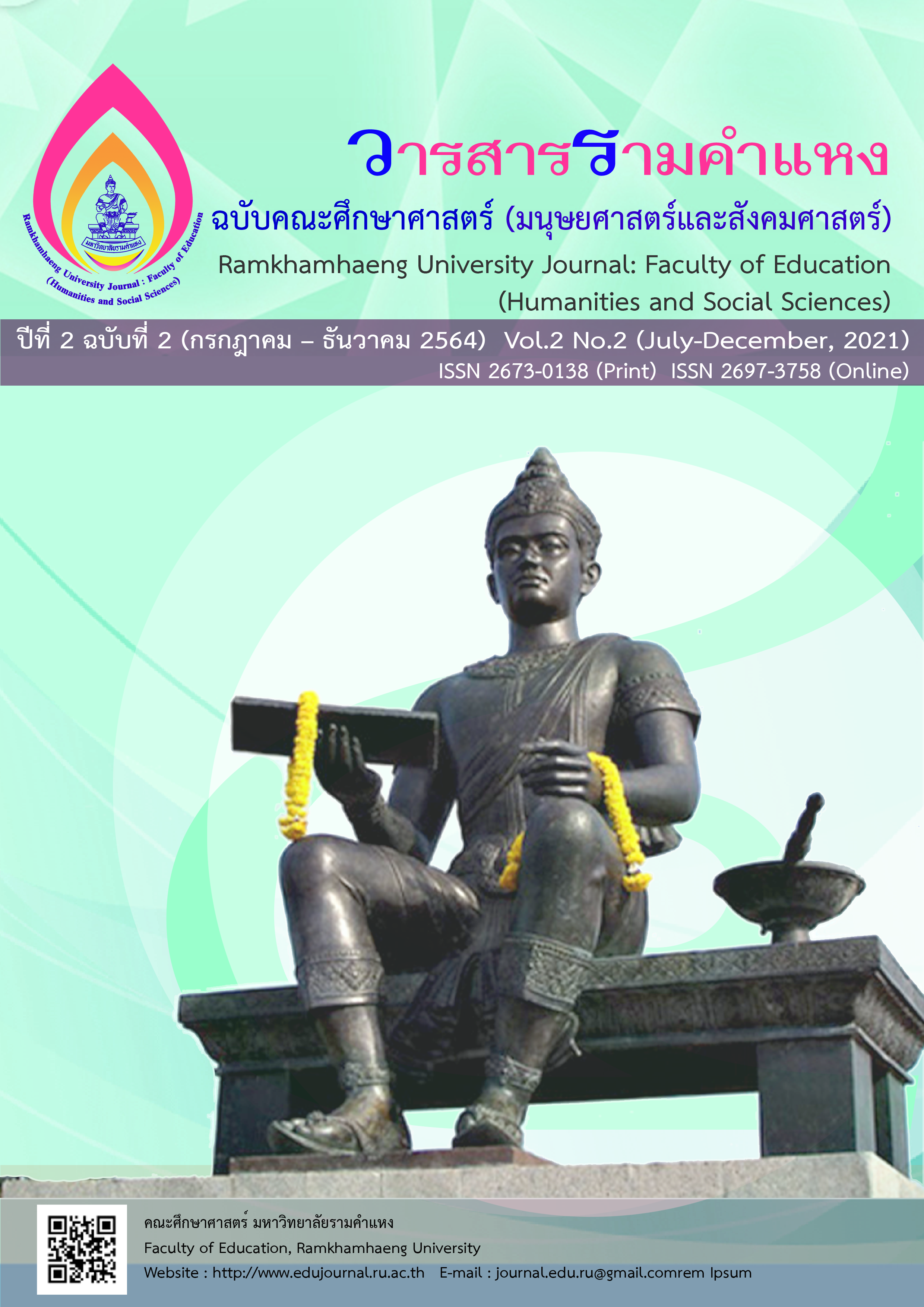Factors Related to Obesity Prevention Behaviors of Students at the Demonstration School, Ramkhamhaeng University, Bangkok
Main Article Content
Abstract
The objectives of this research were (1) to study the personal, predisposing, enabling, and reinforcing factors and also obesity prevention behaviors of students at the demonstration school, Ramkhamhaeng university, Bangkok, and (2) to study the relationships among the personal, predisposing, enabling, and reinforcing factors with obesity prevention behaviors of students at the demonstration school, Ramkhamhaeng university.
The sample used in this study was the first year of 170 high school students of the demonstration school, Ramkhamhaeng university. The questionnaires used in this research covered contents with 5 sections, i.e., personal factors, predisposing factors (knowledge and self-efficacy), enabling factors (access to facilities of fitness places, and cafeteria), reinforcing factors in preventing obesity (social supports from families, friends and teachers) and obesity prevention behaviors. The reliability of this questionnaire was 0.958. The data were collected during 11-18 February 1962, and were analyzed using descriptive statistics, percent, mean, standard deviation, Chi-square test, and Pearson's product moment correlation coefficients with a level of significance at p = .05.
The findings of this study revealed that most sample was male (54.10 percent). About 52.40 percent of sample students had body mass index classified as obesity level (BMI > 23.5). Students' family incomes were between 15,000-176,666 Baht per month (98.80 percent). Students received parents' money about 60-106 baht per day (79.40 percent). Students had both knowledge (43.50 percent) and self-efficacy (52.9 percent) in preventing obesity at medium level. Also, students had both enabling factors (40.00 percent), and reinforcing factors (47.60 percent) in preventing obesity at high level. Whereas, students' obesity prevention behaviors (46.50 percent) were at medium level. In terms of association analysis, sex and nutrition status were associated with obesity prevention behaviors, ( X2 = 23.60, and 42.13, respectively), statistically significant at the0.01 level. The students' money daily received, enabling factors, and reinforcing factors were correlated with obesity prevention behaviors, (r=0.614, 0.747, and 0641, respectively), statistically significant at the .01 level. Self-efficacy was also correlated with obesity prevention behaviors,(r = 0.160), statistically significant at the .05 level. Average family's incomes and knowledges about obesity had no relationships with obesity prevention behaviors (p > .05).
Downloads
Article Details

This work is licensed under a Creative Commons Attribution-NonCommercial-NoDerivatives 4.0 International License.
ผู้ส่งบทความ (และคณะผู้วิจัยทุกคน) ตระหนักและปฎิบัติตามจริยธรรมการวิจัยอย่างเคร่งครัด ทั้งนี้บทความ เนื้อหา ข้อมูล ข้อความ ภาพ ตาราง แผนภาพ แผนผัง หรือข้อคิดเห็นใดๆ ที่ปรากฎในบทความ เป็นความคิดเห็นและความรับผิดชอบของผู้ส่งบทความ กองบรรณาธิการไม่จำเป็นต้องเห็นตามเสมอไป และไม่มีส่วนรับผิดชอบใดๆ โดยถือเป็นความรับผิดของของเจ้าของบทความเพียงผู้เดียว
References
Boonlong, N. (2013). Food for human. Bangkok: Kasetsart University.
Chinsriwongul, N. (2010). Factors affecting dietary habits of overweight students in the primary schools under the office of private education commission. Unpublished master's thesis, Chulalongkorn University, Bangkok.
Deepromt, C. (2012). Factors in correlation with overweight prevention behaviors of high school student in Surin province. Unpublished master's thesis, Khon Kaen University, Khon Kaen.
Division of Nutrition, Ministry of Public Health, (2016). Over standard nutritional status in secondary school students age 11-17 years in Bangkok. Bangkok: Ministry of Public Health.
Hirunpreuk, W. (2005). Family and environmental factors influencing the prevention of overweight female adolescents in Chonburi province. Unpublished master's thesis, Burapa University, Chonburi.
Huatsiri, K. (2014). Knowledge about food and dietary habits that cause obesity among adolescents in Bangkok. Unpublished master's thesis, Kasetsart University, Bangkok.
Junaim, S. (1997). Developmental psychology. Bangkok: Thai Watana Panich Publication.
Kunthawong, O. (2000). Healthy habits regarding food consumption of national health and nutrition act of grade 1 students, the school expanded educational opportunities under Bangkok education division. Unpublished master's thesis, Srinakharinwirot University, Bangkok.
Mohsuwan, L. (2014). The growth and nutritional status of children in Thailand: The collection of research projects, development of holistic child Thailand. Greater Cage: Fund Research.
Poramutthavorn, W. (2014). Exercise. Bangkok: Odeon Store Printing.
Ramkhamhaeng University Demonstration School. (2018). Health data of nursing room students in 2018, Bangkok: Author.
Rattanawijit, A. (2010). Effects of knowledge in their practice using the process of weight loss in people with weight. Unpublished master's thesis, Mahidol University, Bangkok.
Thongtruntri, N. (2008). Self-efficacy and practice in preventing obesity among adolescent girls. Unpublished master's thesis, Chiang Mai University, Chiang Mai.
Tungtrongchitr, R. (2012). Obesity changes in nutrition and biochemistry. Bangkok: Mahidol University.
Vorapongsathorn, S. (2015). Research in education (3rd ed.). Bangkok: Vitoon Kampok Printing.
Vorapongsathorn, T., & Vorapongsathorn, S. (2018). Sample size calculation for research using G* Power program. Journal of Health Promotion and Environmental Health, 41(2), 11-21.
Witayangoon, P. (2016). Adolescent development. Bangkok: Thai Watana Panich Publication.
Yaowapongsiri, W., & Chunhasawadikul, B. (2008). Eat meat, eat vegetables, diabetes without fasting. Bangkok: Usa Printing.


